Raising the Dead
- Share via
Obituaries have changed much over the years. Through the first half of the 20th century, obituaries were generally reserved for people thought to be leaders of the community. This was a fairly narrow list of people, almost all male and all white, and generally included politicians, clergymen, business leaders and college presidents.
They were written in spare, stilted language and, on close examination, seemed to be little more than resumes in disguise, recounting the colleges the deceased attended, the businesses they ran and the clubs they belonged to. There was little detail of what made that person’s life interesting. There were also few people of color on the obituary page and still fewer women.
But as society has changed since the 1960s, so has the view of obituaries. In leading newspapers today, the notion of somber eulogy for the very few has been replaced by the idea that obituaries can be lively pieces--profiles, if you will--on a vast array of people who may have had a large or small effect on our common history.
In the last half of the 1990s, the finest practitioner of the obituary form was Robert McG. Thomas Jr. of the New York Times. His send-offs for the underreported and disenfranchised, those he most often chronicled, brought new vigor to the obituary form. Unlike Alden Whitman, the legendary New York Times writer of decades ago who virtually created the advance obituary form, Thomas generally worked after the fact, writing daily obituaries on deadline. Whitman would extensively research and often interview noteworthy people and then write advance obituaries that were filed away until nature took its course; Thomas usually had just a few hours to place a person’s life in context.
As writer Thomas Mallon notes correctly in the foreword to “52 McGs,” Thomas’ writing is “full of wit” and without a trace of condescension. “His send-offs were funny, stylish and unfailingly soulful,” Mallon writes.
Working from clippings and perhaps some telephone interviews, Thomas painted word pictures as well as anyone in American journalism. His lead on the obituary of Anton Rosenberg, the Greenwich Village hipster, is as good an example as any of his skill: “Anton Rosenberg, a storied sometime artist and occasional musician who embodied the Greenwich Village hipster ideal of 1950s cool to such a laid-back degree and with some determined detachment that he never amounted to much of anything, died on Feb. 14 at a hospital in Woodstock, N.Y. He was 71 and best known as the model for the character Julian Alexander in Jack Kerouac’s novel ‘The Subterraneans.’”
Magic. Leads on newspaper stories don’t get much better than this.
So it was with real sadness that I picked up the New York Times obituary page on Jan. 8, 2000, and found an obituary on Thomas himself, who had died of cancer at the age of 60. Born in Shelbyville, Tenn., Thomas began working at the New York Times as a copy boy in 1959 and went on to hold a number of jobs there over the years, including police reporter, sports writer, society reporter and rewrite man. In 1995, he found his niche writing obituaries for the paper.
Apparently, I was not the only person dismayed at the death of this newspaper legend, as witnessed by “52 McGs,” a slight volume containing some of Thomas’ finest pieces. Chris Calhoun, a literary agent and longtime collector of Thomas’ work, noticed his absence from the Times’ obituary pages long before I did and wrote him a “get well” note. After Thomas’ death, Calhoun set about the task of compiling a collection of Thomas’ pieces.
In an editor’s note, Calhoun wrote that he selected 52 because “I liked the sound of 52” and because it gave a good sampling of what Calhoun calls his “ungovernable range.” To be trite but accurate, the death of Thomas has left a void in the lineup of newspaper obituary writing. And while there are many excellent writers in the obit arena, few have his consistently distinctive and original voice.
Some looking at “52 McGs” might resort to the bromide that these are textbook pieces. But really they go beyond that. They are excellent examples of the writer’s craft and the magic that can be found in one of the few forms of journalism generally left to the newspapers, the obituary.
*
Jon Thurber is executive obituary editor for the Los Angeles Times.
More to Read
Sign up for our Book Club newsletter
Get the latest news, events and more from the Los Angeles Times Book Club, and help us get L.A. reading and talking.
You may occasionally receive promotional content from the Los Angeles Times.







